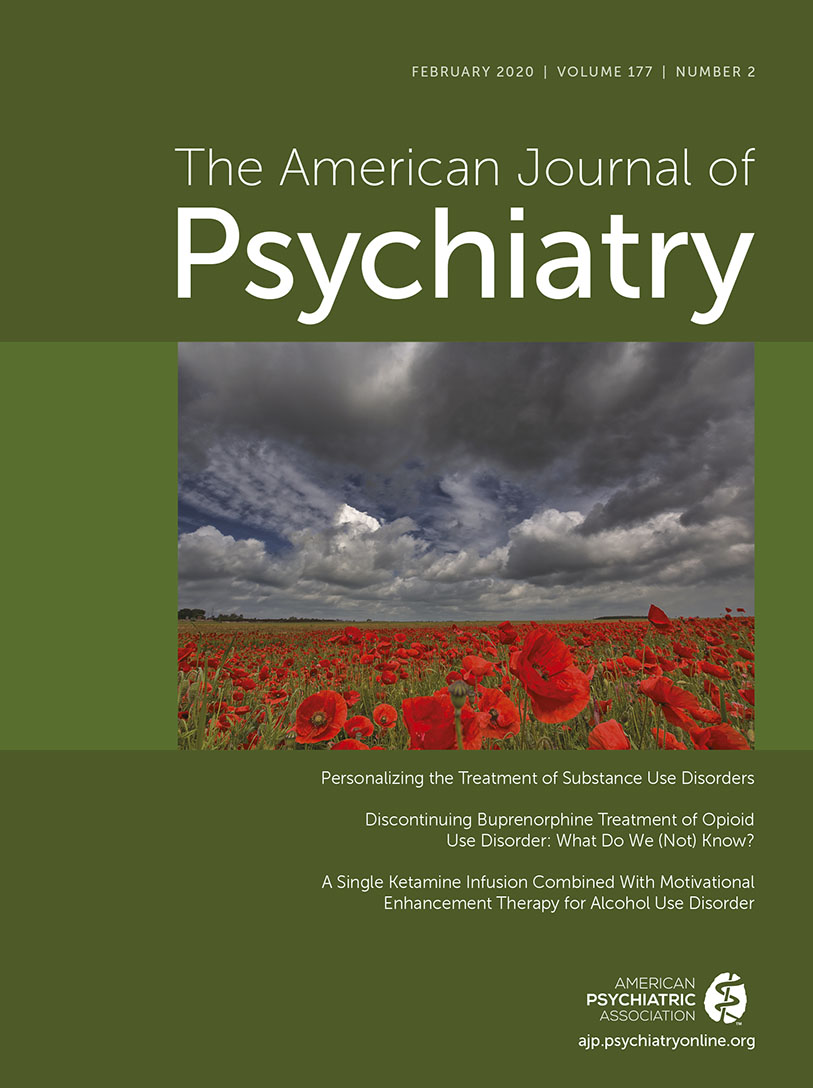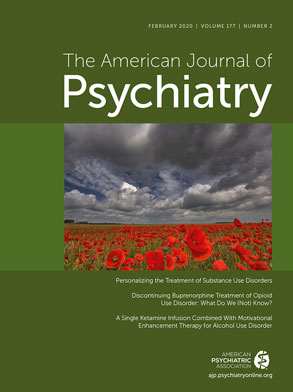Clinicians have the following conversation all the time with patients, families, colleagues, insurance providers, and policy makers:
“How long does someone with opioid use disorder need to stay on buprenorphine?”
“Mm, long enough.”
Long enough for what? What needs to happen for someone who decides to discontinue buprenorphine to have a reasonable chance of sustaining recovery from opioid use disorder?
Buprenorphine is one of three medications approved by the U.S. Food and Drug Administration (FDA) for opioid use disorder. Its efficacy is due to its partial agonist activity at central mu-opioid receptors, providing relief from opioid withdrawal and opioid craving and effective competitive antagonism when a person uses other opioids (
1). By these mechanisms, it provides a very effective and protective support for persons with opioid use disorder, especially during their first years learning how to live life without other opioids. So in answering the question “how long,” let us first emphasize that we do not recommend or encourage patients to stop buprenorphine (or either of the other two FDA-approved medications for opioid use disorder, methadone and naltrexone). Quite the opposite: patients need to be warned during shared decision making that stopping medications for opioid use disorder is a risky endeavor associated with relapse risk and, in turn, the potential for fatal overdose (
2). That said, many patients will decide to stop taking buprenorphine, and will do so either without discussion (the most risky) or after consulting their prescribing clinician on what to expect and what is the safest way to stop. In this issue of the
Journal, a study by Williams and colleagues (
3) offers some helpful new information for guidance.
The study implemented a retrospective national longitudinal cohort analysis of adult Medicaid patients with opioid use disorder who had filled buprenorphine prescriptions for a minimum of 6 consecutive months before discontinuing refills. The aim of the study was to examine how the duration of a stabilization period of buprenorphine treatment (i.e., continuous treatment for a minimum of 6 months) is related to health outcomes during a 6-month period following buprenorphine discontinuation. Specifically, the outcomes examined were all-cause emergency department visits and hospitalizations, receipt of an opioid analgesic prescription, and the occurrence of a medically treated drug overdose event (opioid or nonopioid). Strengths of the study design include recent data cohorts (2013–2017), which reduces outcome variability attributable to secular trends; the large sample size of nearly 9,000 Medicaid patients without concurrent Medicare benefit; and adjustment in the data analysis for Medicaid plan by type. As the authors note, Medicaid is currently the largest single payer for providing substance use disorder services in the United States. Limitations of the study include its retrospective nature and its inability to examine individual patient factors other than treatment duration that might predict likelihood of successful discontinuation of buprenorphine.
The study compared outcomes among four buprenorphine treatment duration intervals: 6–9 months, 9–12 months, 12–15 months, and 15–18 months. The 15- to 18-month cohort was significantly less likely to be seen in an emergency department, to be hospitalized, or to receive a prescription for an opioid analgesic during the 6-month postdiscontinuation period compared with the 6- to 9-month cohort (odds ratios, 0.75, 0.79, and 0.67 for the three outcomes, respectively). Yet all cohorts had high rates of emergency department visits following discontinuation (>40%), and all cohorts had indistinguishable rates of nonfatal drug overdose, at approximately 5.6% of the sample. Fatal drug overdose could not be detected in this study, as termination of Medicaid enrollment before 6 months postdiscontinuation rendered that record ineligible for study inclusion.
In sum, the study showed that longer treatment was better; this is unsurprising but important to document. This study finding is congruent with data from the United Kingdom showing that patients with opioid use disorder who had taken buprenorphine for at least 2 years had better chances of successful discontinuation than did those who had a shorter treatment history (
4). Would 3 years, or even more, be better than 2? We don’t know; however, we do know that duration of buprenorphine treatment is only part of the story. The other part is what happened during the treatment period: Did the patient engage successfully in the many processes of recovery, which include not just making lifestyle changes but also relational and identity adjustments, addressing psychological and physical health barriers to wellness, and establishing personal and family security? Did he or she achieve sufficient changes to navigate the stresses associated with discontinuation of the medication, including managing opioid withdrawal without opioid relapse?
Recovery is harder than it looks from the outside. When we counsel our patients with substance use disorders to reduce or stop using substances, it is essential that we bear in mind exactly what we are asking of them: to exert an athletic level of discipline and sustained determination, without much training or experience, in behavioral self-control that is fully counter to their neurobiological drives, and all too often supported only by fear incentives (loss of work, relationships, or health). Continuing care experts have outlined the seriousness of this problem for patients as it relates to poor long-term outcomes in substance use disorders, noting that fear incentives may be effective in the short term in times of crisis, but positive incentives such as purpose, financial security, and meaningful work and relationships are necessary to avoid the natural fatigue of sustaining long-term recovery from substance use disorders (
5). We are asking for on-the-spot Stoicism and the enduring practice of what Epictetus named as the most important of the essential three disciplines for virtuous living: “that which relates to desires and aversions, so that he may neither fail to get what he desires, nor fall into what he wants to avoid” (
6). More than that, we are asking affected individuals to ignore the first part of this dialectical balance and to voluntarily and permanently give up what they most desire, suggesting only vague hopes that they will be grateful to avoid what they wish to avoid and will eventually develop new desires. But how?
Sustained treatment duration for substance use disorder
is significantly associated with patient-reported positive outcomes in quality of life and reduced stress, but the capacity to sustain treatment-facilitated recovery is also predicted by availability of “recovery capital,” such as having social supports, friends who don’t use substances of abuse, life meaning, spirituality in daily life, and affiliation with recovery networks such as may be provided within mutual support programs (e.g., 12-step programs such as Alcoholics Anonymous and Narcotics Anonymous) (
7). Many patients with opioid use disorder enter treatment without much recovery capital. Although the Williams et al. study does not examine proxy measures of recovery capital, given the high rates (65%) of buprenorphine discontinuation
before 6 months in Medicaid cohorts (
8), it would not be unreasonable to consider that longer-treatment-duration cohorts such as those in this study have some recovery capital advantages supporting retention in care; these advantages may facilitate or predict better health outcomes following buprenorphine discontinuation. While longer treatment and the achievement of recovery capital will likely improve outcomes for opioid use disorder on a population level, individuals remain at risk. Opioid use disorder specifically requires an aggressive treatment approach because of its inherent potential lethality with even a single instance of opioid relapse, which is probable even after lengthy periods (>10 years) of opioid abstinence (
9). For many, this relapse potential endures regardless of continuous treatment utilization (
10).
This reality is what separates opioid use disorder treatment from other substance use disorder treatment paradigms: In opioid use disorder, long-term recovery does not appear to reduce overdose risk without the benefit of continuing an opioid use disorder medication that protects against opioid relapse–induced respiratory depression. Unlike alcohol use disorder, for which harm reduction measures to contain some of the immediate life-threatening negative consequences of a drinking relapse are readily implementable (e.g., don’t drive, don’t operate machinery, don’t go swimming after drinking), it is highly improbable that a person with opioid use disorder who has relapsed while alone will be able to successfully implement naloxone reversal of opioid overdose. Ironically, a high rate of early buprenorphine discontinuation is strongly predicted by history of prior overdose (
8), even though buprenorphine treatment is very likely to prevent a future overdose. Antagonist therapy for opioid use disorder—extended-release naltrexone—has demonstrated efficacy in preventing opioid relapse during active treatment (
11), but discontinuation rates after 30 days are even worse than for the agonist therapies (
12).
What is to be done about improving retention in medication treatment for opioid use disorder and, when needed or appropriate, improving outcomes following medication discontinuation? A large study conducted under the auspices of the National Drug Abuse Treatment Clinical Trials Network and supported by the National Institutes of Health’s Helping to End Addiction Over the Long Term (HEAL) initiative (
13) will be the first large multisite prospective study of buprenorphine discontinuation among patients who have achieved stability on the medication. The study, entitled “Optimizing Retention, Duration, and Discontinuation Strategies for Opioid Use Disorder,” will examine, among other things, predictors of successful discontinuation as well as optimal pharmacologic and behavioral strategies for successful discontinuation. Notably, participants will be identified as eligible only after a prescriber has warned them about the risks of discontinuation but they continue to choose discontinuation. It is hoped that the results of this and other HEAL studies will help us in informing patients and communities more fully when they ask us about the likely outcome of buprenorphine discontinuation.

